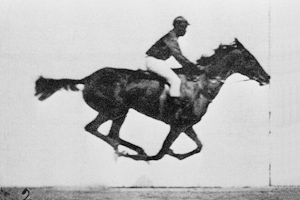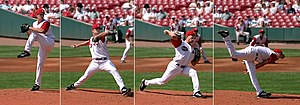The book and its principles have become generally adopted, and have been referred to as the "Bible of animation."[2] In 1999 the book was voted number one of the "best animation books of all time" in an online poll.[3] Though originally intended to apply to traditional, hand-drawn animation, the principles still have great relevance for today's more prevalent computer animation.
Contents1 The 12 principles
1.1 Squash and stretch
1.2 Anticipation
1.3 Staging
1.4 Straight ahead action and pose to pose
1.5 Follow through and overlapping action
1.6 Slow in and slow out
1.7 Arcs
1.8 Secondary action
1.9 Timing
1.10 Exaggeration
1.11 Solid drawing
1.12 Appeal
2 Notes
3 References
4 Further reading
The 12 principles[edit]
Squash and stretch[edit]

Illustration of the "squash and stretch"-principle:
Example A shows a ball bouncing with a rigid, non-dynamic movement. In example B the ball is "squashed" at impact, and "stretched" during fall and rebound. The movement also accelerates during the fall, and slows down towards the apex (see "slow in and slow out").
Example A shows a ball bouncing with a rigid, non-dynamic movement. In example B the ball is "squashed" at impact, and "stretched" during fall and rebound. The movement also accelerates during the fall, and slows down towards the apex (see "slow in and slow out").

Animated sequence of a race horse galloping. Photos taken by Eadweard Muybridge. The horse's body demonstrates squash and stretch in natural musculature.
Anticipation[edit]
Anticipation is used to prepare the audience for an action, and to make the action appear more realistic.[9] A dancer jumping off the floor has to bend his knees first; a golfer making a swing has to swing the club back first. The technique can also be used for less physical actions, such as a character looking off-screen to anticipate someone's arrival, or attention focusing on an object that a character is about to pick up.[10]Staging[edit]
This principle is akin to staging as it is known in theatre and film.[13] Its purpose is to direct the audience's attention, and make it clear what is of greatest importance in a scene; [14] Johnston and Thomas defined it as "the presentation of any idea so that it is completely and unmistakably clear", whether that idea is an action, a personality, an expression or a mood.[13] This can be done by various means, such as the placement of a character in the frame, the use of light and shadow, and the angle and position of the camera.[15] The essence of this principle is keeping focus on what is relevant, and avoiding unnecessary detail.[16][17]Straight ahead action and pose to pose[edit]
These are two different approaches to the actual drawing process. "Straight ahead action" means drawing out a scene frame by frame from beginning to end, while "pose to pose" involves starting with drawing a few key frames, and then filling in the intervals later.[14] "Straight ahead action" creates a more fluid, dynamic illusion of movement, and is better for producing realistic action sequences. On the other hand, it is hard to maintain proportions, and to create exact, convincing poses along the way. "Pose to pose" works better for dramatic or emotional scenes, where composition and relation to the surroundings are of greater importance.[18] A combination of the two techniques is often used.[19]Computer animation removes the problems of proportion related to "straight ahead action" drawing; however, "pose to pose" is still used for computer animation, because of the advantages it brings in composition.[20] The use of computers facilitates this method, as computers can fill in the missing sequences in between poses automatically. It is, however, still important to oversee this process and apply the other principles discussed.[19]
Follow through and overlapping action[edit]
Follow through and overlapping action is a general heading for two closely related techniques which help to render movement more realistically, and help to give the impression that characters follow the laws of physics. "Follow through" means that separate parts of a body will continue moving after the character has stopped. "Overlapping action" is the tendency for parts of the body to move at different rates (an arm will move on different timing of the head and so on). A third related technique is "drag", where a character starts to move and parts of him take a few frames to catch up.[14] These parts can be inanimate objects like clothing or the antenna on a car, or parts of the body, such as arms or hair. On the human body, the torso is the core, with arms, legs, head and hair appendices that normally follow the torso's movement. Body parts with much tissue, such as large stomachs and breasts, or the loose skin on a dog, are more prone to independent movement than bonier body parts.[21] Again, exaggerated use of the technique can produce a comical effect, while more realistic animation must time the actions exactly, to produce a convincing result.[22]Thomas and Johnston also developed the principle of the "moving hold". A character not in movement can be rendered absolutely still; this is often done, particularly to draw attention to the main action. According to Thomas and Johnston, however, this gave a dull and lifeless result, and should be avoided. Even characters sitting still can display some sort of movement, such as the torso moving in and out with breathing.[23]
Slow in and slow out[edit]
The movement of the human body, and most other objects, needs time to accelerate and slow down. For this reason, animation looks more realistic if it has more drawings near the beginning and end of an action, emphasizing the extreme poses, and fewer in the middle.[14] This principle goes for characters moving between two extreme poses, such as sitting down and standing up, but also for inanimate, moving objects, like the bouncing ball in the above illustration.[24]Arcs[edit]
Most natural action tends to follow an arched trajectory, and animation should adhere to this principle by following implied "arcs" for greater realism. This can apply to a limb moving by rotating a joint, or a thrown object moving along a parabolic trajectory. The exception is mechanical movement, which typically moves in straight lines.[25]As an object's speed or momentum increases, arcs tend to flatten out in moving ahead and broaden in turns. In baseball, a fastball would tend to move in a straighter line than other pitches; while a figure skater moving at top speed would be unable to turn as sharply as a slower skater, and would need to cover more ground to complete the turn.
An object in motion that moves out of its natural arc for no apparent reason will appear erratic rather than fluid. Therefore when animating (for example) a pointing finger, the animator should be certain that in all drawings in between the two extreme poses, the fingertip follows a logical arc from one extreme to the next. Traditional animators tend to draw the arc in lightly on the paper for reference, to be erased later.



No comments:
Post a Comment